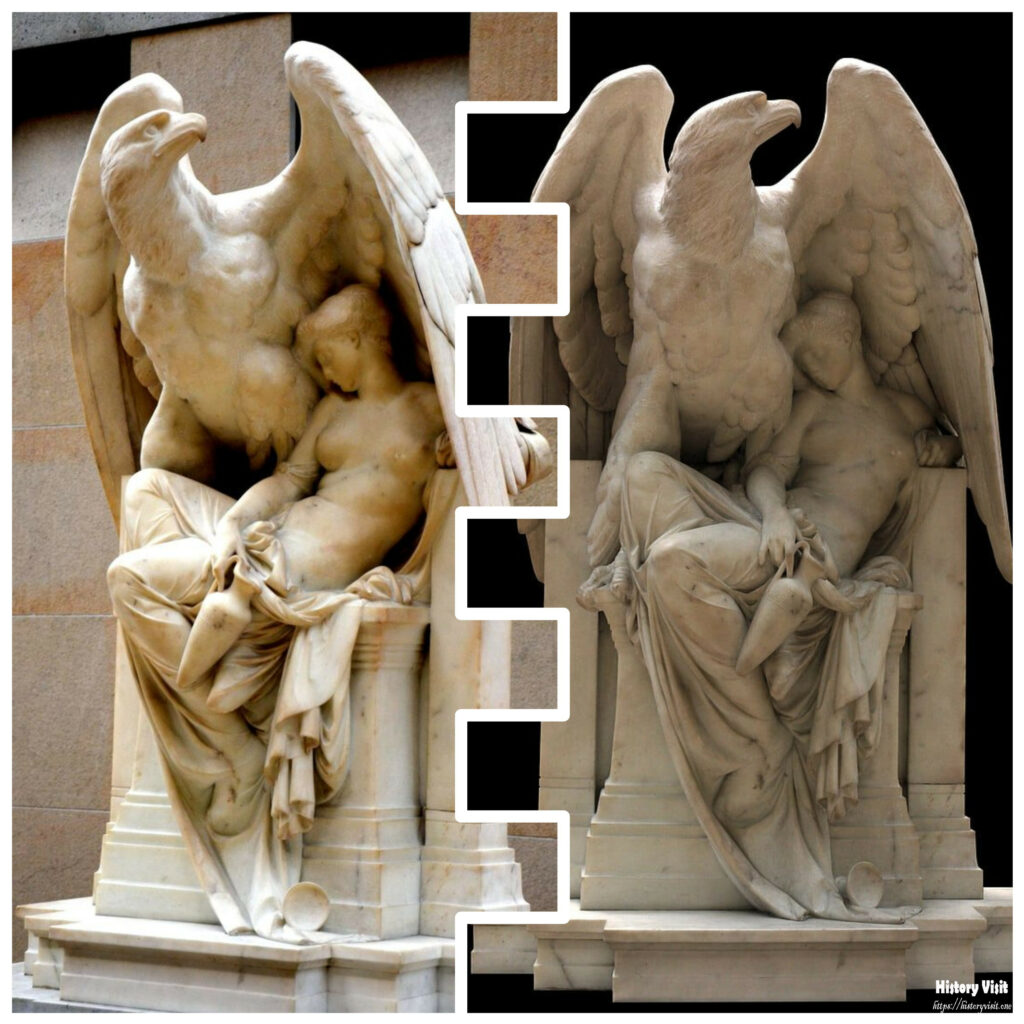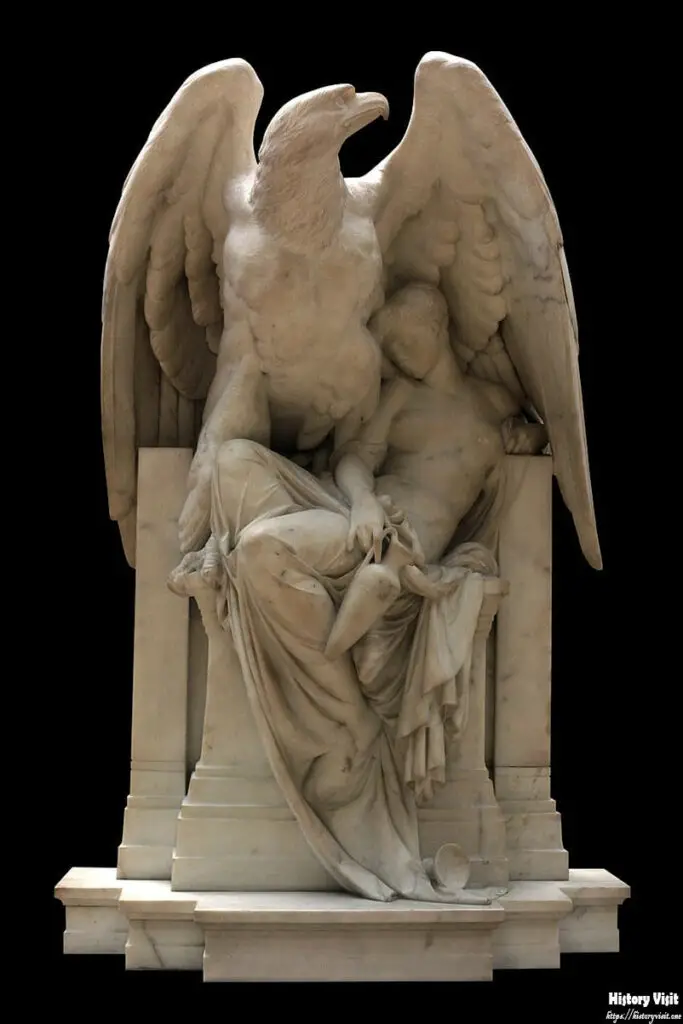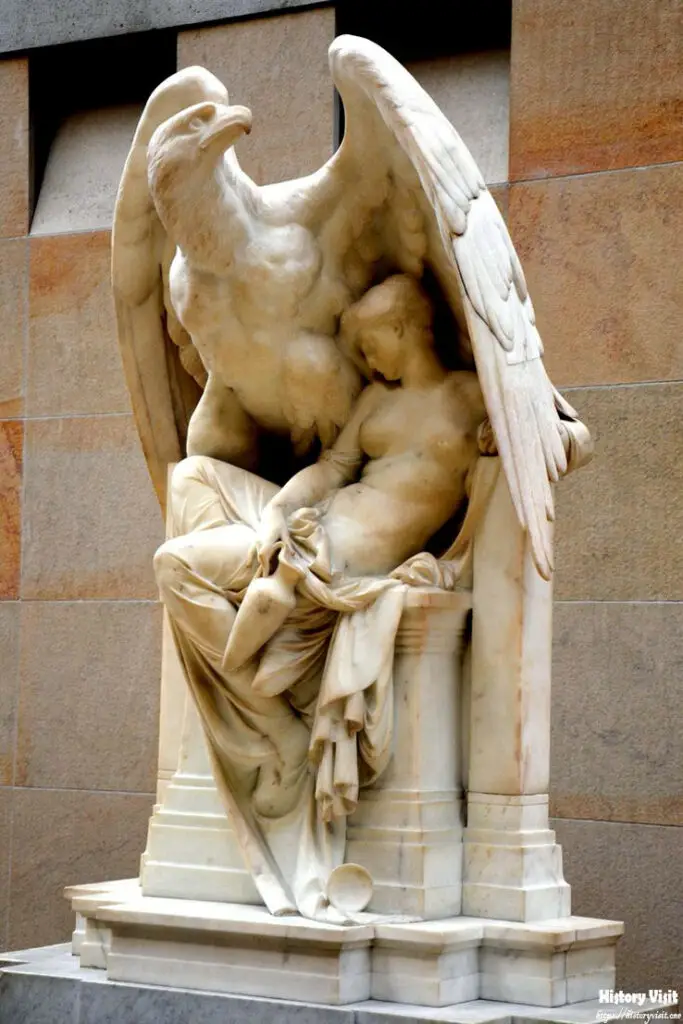Hebe Asleep: The Enchanting Sculpture by Albert-Ernest Carrier-Belleuse

Introduction
Albert-Ernest Carrier-Belleuse, a celebrated French sculptor of the 19th century, is renowned for his exceptional ability to capture the elegance and beauty of the human form. His works, which span various mediums including bronze, marble, and terracotta, reflect a mastery of classical aesthetics blended with a nuanced understanding of naturalism and romanticism. Among his most enchanting creations is the sculpture “Hebe Asleep,” a piece that epitomizes his skill in conveying grace and tranquility through art.
“Hebe Asleep” is a captivating representation of Hebe, the Greek goddess of youth. In this sculpture, Carrier-Belleuse departs from the traditional dynamic depictions of Hebe serving the gods and instead portrays her in a serene moment of repose. This choice not only highlights the artist’s innovative approach to classical themes but also invites viewers to contemplate the peaceful and restorative aspects of youth. The sculpture stands as a testament to Carrier-Belleuse’s ability to blend technical excellence with profound emotional depth.
The Artist: Albert-Ernest Carrier-Belleuse
Albert-Ernest Carrier-Belleuse, born in 1824 in Anizy-le-Château, France, was a pivotal figure in 19th-century European art. Trained at the prestigious École des Beaux-Arts in Paris, he honed his skills under the tutelage of renowned sculptors such as David d’Angers and François Rude. Carrier-Belleuse’s early works quickly garnered attention, leading him to work in England for several years, where he further refined his style and technique. Upon returning to France, he continued to build his reputation, eventually becoming one of the most sought-after sculptors of his time.
Carrier-Belleuse’s oeuvre is characterized by its wide range and versatility. He was adept in various mediums including bronze, marble, and terracotta, each piece reflecting his impeccable craftsmanship and artistic vision. His style, while rooted in classical tradition, often incorporated elements of naturalism and romanticism, making his works both timeless and appealing to contemporary audiences. He was not only a sculptor but also a skilled designer, contributing to decorative arts and influencing the aesthetic directions of his era.
Beyond his own creations, Carrier-Belleuse’s influence extended through his role as a mentor. One of his most famous pupils was Auguste Rodin, who would later revolutionize the field of sculpture. Under Carrier-Belleuse’s guidance, Rodin developed a strong foundation in traditional techniques while also embracing innovative approaches. This mentorship highlights Carrier-Belleuse’s impact on the trajectory of modern sculpture, cementing his legacy not just through his works but also through his contributions to the artistic community.
The Mythological Inspiration: Hebe

Hebe, in Greek mythology, is the goddess of youth, symbolizing eternal beauty and vitality. She is the daughter of Zeus, the king of the gods, and Hera, the goddess of marriage and family. As the cupbearer to the gods, Hebe served ambrosia and nectar, the divine sustenance that granted immortality. Her role in mythology is often associated with the rejuvenating and life-giving aspects of youth, making her a beloved figure in ancient Greek culture.
In art, Hebe has been a popular subject since antiquity, often depicted as a beautiful young woman in flowing garments, sometimes holding a cup or a jug. These representations aim to capture her essence as the embodiment of youthful grace and elegance. Artists throughout the centuries have been drawn to her story and her symbolism, creating numerous works that explore different facets of her divine character. Hebe’s iconography is rich with themes of renewal and perpetual youth, making her an enduring muse for many.
Carrier-Belleuse’s “Hebe Asleep” offers a unique interpretation of this mythological figure. Instead of the more common depictions of Hebe in action, serving the gods, he presents her in a moment of serene repose. This choice not only highlights her beauty but also adds a layer of human vulnerability and tranquility to the divine character. By portraying Hebe asleep, Carrier-Belleuse invites viewers to reflect on the peaceful and restorative aspects of youth, capturing a rare, intimate moment of the goddess at rest.
“Hebe Asleep”: A Study in Serenity

Carrier-Belleuse’s “Hebe Asleep” is a masterful depiction of the goddess in a state of tranquil slumber. The sculpture captures her reclining gracefully, with her body naturally curved in a relaxed posture. Her head rests gently on her arm, and her expression is one of serene calm, exuding a sense of peacefulness. The folds of her draped garment are intricately carved, enhancing the sculpture’s realism and softness, making the marble appear almost like delicate fabric.
The attention to detail in “Hebe Asleep” is a testament to Carrier-Belleuse’s technical skill. The smooth, polished surfaces of the sculpture contrast beautifully with the finely textured areas, such as the delicate folds of Hebe’s attire and the soft waves of her hair. This interplay of textures creates a dynamic visual experience, drawing the viewer’s eye across the sculpture and inviting close inspection. The artist’s use of light and shadow further enhances the sense of depth and dimension, bringing the figure to life.
The composition of “Hebe Asleep” is both balanced and harmonious, reflecting Carrier-Belleuse’s understanding of classical aesthetics. Despite the stillness of the figure, there is a subtle sense of movement conveyed through the gentle curves of her body and the flowing drapery. This dynamic quality suggests a moment frozen in time, capturing the goddess in a state of restful beauty. Carrier-Belleuse’s ability to convey such a nuanced emotional and physical state in marble underscores his mastery as a sculptor.
Artistic Elements and Techniques

Carrier-Belleuse’s use of marble in “Hebe Asleep” showcases his exceptional ability to manipulate the medium to achieve both realism and artistic expression. The sculpture’s surface is meticulously polished, giving it a lifelike sheen that enhances its visual appeal. The artist’s attention to the play of light on the marble surface creates a sense of depth and texture, making the figure appear almost ethereal. This effect is particularly evident in the delicate rendering of Hebe’s facial features and the intricate folds of her garment.
One of the most striking elements of “Hebe Asleep” is the contrast between the smooth, polished surfaces and the finely detailed areas. This contrast not only adds visual interest but also highlights the artist’s technical prowess. The delicate handling of the marble allows for the creation of soft, flowing lines that mimic the natural curves of the human body. The drapery, in particular, is a marvel of craftsmanship, with its intricate folds and subtle shading creating a sense of movement and fluidity.
Carrier-Belleuse’s composition also demonstrates his keen eye for balance and proportion. The reclining figure of Hebe is positioned in a way that feels both natural and harmonious, with each element of the sculpture contributing to a cohesive whole. The careful positioning of her limbs and the gentle arch of her back create a sense of relaxed elegance, while the overall composition draws the viewer’s eye along a graceful, sweeping line. This attention to composition and form is a hallmark of Carrier-Belleuse’s work, reflecting his deep understanding of classical principles and his ability to infuse them with a sense of contemporary vitality.
Legacy and Impact

“Hebe Asleep” is more than just a representation of a mythological figure; it is a timeless embodiment of youthful beauty and tranquility. Carrier-Belleuse’s work continues to be admired for its artistic excellence and emotional depth. This sculpture, like many of his works, bridges the gap between classical themes and contemporary aesthetics, making it a cherished piece in the annals of art history. Its serene beauty and masterful execution ensure that it remains a focal point of study and admiration in art circles.
Carrier-Belleuse’s influence extends beyond his own creations; his role as a mentor to Rodin helped shape the future of sculpture, blending traditional techniques with innovative approaches that would redefine the art form. Under Carrier-Belleuse’s mentorship, Rodin developed a foundation in classical techniques while exploring new ways to express movement and emotion in his works. This mentorship is a testament to Carrier-Belleuse’s lasting impact on the evolution of sculpture, illustrating how his teachings helped bridge the gap between classical traditions and modernist innovations.
“Hebe Asleep” remains a testament to Carrier-Belleuse’s enduring legacy, captivating audiences with its serene beauty and masterful execution. The sculpture continues to inspire and enchant art lovers around the world, demonstrating the timeless appeal of Carrier-Belleuse’s artistic vision. As an exquisite example of 19th-century sculpture, “Hebe Asleep” stands as a lasting tribute to the artist’s skill and his ability to capture the essence of youthful beauty and tranquility in marble. This sculpture not only highlights Carrier-Belleuse’s artistic prowess but also underscores his significant contributions to the world of art.
Conclusion

“Hebe Asleep” is more than just a representation of a mythological figure; it is a timeless embodiment of youthful beauty and tranquility. Carrier-Belleuse’s work continues to be admired for its artistic excellence and emotional resonance, bridging the gap between classical themes and contemporary aesthetics. This sculpture, like many of his works, remains a cherished piece in the annals of art history, capturing the serene beauty of the goddess of youth in a moment of perfect stillness.
Albert-Ernest Carrier-Belleuse’s legacy extends far beyond his own creations, influencing the future of sculpture through his mentorship of Auguste Rodin and his innovative approaches to traditional techniques. “Hebe Asleep” stands as a lasting tribute to his skill and vision, continuing to inspire and enchant art lovers around the world. This exquisite example of 19th-century sculpture highlights Carrier-Belleuse’s significant contributions to the world of art and underscores the enduring appeal of his artistic vision.


